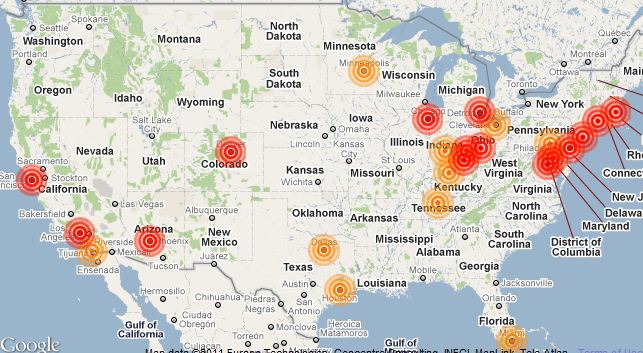Bed bugs have made a remarkable comeback in recent years, turning homes and hotels into battlegrounds. As we dive into the America's most bed bug infested cities 2024 report, you'll discover just how widespread this issue has become.
These tiny pests are not just a nuisance; they can disrupt lives and tarnish reputations. With urbanization on the rise, many cities are grappling with alarming infestation rates, making it crucial to stay informed about the latest trends.
Join us as we reveal America's most bed bug infested cities 2024, shedding light on an ongoing crisis that affects countless households and travelers alike.
Table of Contents
ToggleData Methodology

Data Collection Sources
To compile the 2024 bed bug infestation report, we relied on various reputable sources. The data primarily comes from leading pest control companies that track infestation trends across the United States.
- Terminix: A major player in pest control, providing insights based on customer service interactions and treatment requests.
- Orkin: Another key contributor, offering data from their extensive network of pest management services.
- Local health departments: They provide valuable information regarding reported infestations and public health concerns.
Criteria for Ranking Cities
The cities were ranked based on specific criteria that reflect the severity of bed bug problems. These criteria include:
- Number of treatments reported by pest control companies.
- Complaints filed by residents regarding bed bug sightings.
- Public health reports highlighting infestation cases.
Analysis Techniques
To ensure accurate results, we employed various statistical methods to analyze the data collected. This included:
- Trend analysis: Identifying patterns over time to understand how infestations have evolved.
- Comparative analysis: Assessing differences between cities to highlight those most affected.
- Correlation studies: Exploring relationships between urban factors and infestation rates.
This rigorous methodology allows us to present a comprehensive view of the current bed bug landscape in America, setting the stage for our findings in the following sections.
Top Bed Bug Infested Cities in America (2024)

Factors Contributing to Bed Bug Infestations
Urbanization and Population Density
As cities grow larger and more densely populated, the likelihood of bed bug infestations increases. Urban environments provide ideal conditions for these pests to thrive, making it crucial to understand this relationship.
High population density means more opportunities for bed bugs to spread from one location to another. In crowded apartments and shared living spaces, the risk of infestation escalates significantly.
Travel Patterns
Traveling is another major factor in the spread of bed bugs. Hotels, motels, and public transportation are common venues where these pests can hitch a ride.
- Tourism hotspots: Cities with high tourist traffic often see increased bed bug reports due to transient populations.
- Business travel: Frequent travelers may unknowingly bring bed bugs home from infested locations.
- Public transport: Buses and trains can serve as conduits for bed bug spread among commuters.
Housing Conditions
The type of housing prevalent in a city also plays a significant role in infestation rates. Older buildings with structural issues can harbor bed bugs more easily than newer constructions.
- Multi-family housing: Apartments and condos often experience higher infestation rates due to shared walls and communal spaces.
- Poor maintenance: Buildings that lack regular pest control measures create inviting environments for bed bugs.
- Frequent turnover: High tenant turnover rates can lead to undetected infestations spreading rapidly.
Understanding these factors is essential for residents and policymakers alike. By addressing urbanization, travel habits, and housing conditions, cities can better combat the ongoing battle against bed bugs.
City Rankings
In 2024, certain cities have emerged as hotspots for bed bug infestations. The following list highlights the top 50 cities where residents are facing significant challenges with bed bugs.
-
Chicago
-
New York
-
Philadelphia
-
Cleveland-Akron, OH
-
Los Angeles
-
Detroit
-
Washington, D.C. (+2)
-
Indianapolis (-1)
-
Charlotte (+5)
-
Champaign, IL (+1)
-
Columbus, OH (-1)
-
Cincinnati (+1)
-
Atlanta (+3)
-
Grand Rapids, MI (-2)
-
Denver
-
Baltimore (-8)
-
Richmond, VA (+9)
-
Greensboro, N.C. (+25)
-
St. Louis (+6)
-
Youngstown (+7)
-
Pittsburgh (-3)
-
Dallas-Ft. Worth (-5)
-
Flint, MI (-2)
-
Raleigh-Durham (-4)
-
Milwaukee (+15)
-
Charleston, W.V. (-7)
-
Greenville, SC (-3)
-
Norfolk, VA (-5)
-
Davenport (+8)
-
Nashville (+3)
-
Tampa (+10)
-
Toledo (+6)
-
Dayton, OH (+1)
-
Knoxville (-4)
-
Las Vegas (new to list)
-
Omaha, NE (-4)
-
South Bend, IN (-9)
-
Houston (+6)
-
Cedar Rapids, IA (-8)
-
Ft. Wayne, IN (-5)
-
San Francisco (-19)
-
Buffalo, NY (-13)
-
Harrisburg (-7)
-
Seattle (-5)
-
Miami
-
Orlando (+1)
-
Minneapolis (new to list)
-
Oklahoma City (new to list)
-
Louisville, KY
-
Lexington, KY (-4)
- Chicago: Continues to lead the nation with the highest number of reported infestations.
- New York: A bustling metropolis where bed bugs thrive in densely populated areas.
- Philadelphia: Notable for its historic buildings, which can harbor these pests.
- Cleveland: Rising in the ranks, this city faces increasing reports of bed bug sightings.
- Los Angeles: A popular tourist destination grappling with bed bug issues in hotels and residences.
- Detroit: Experiencing a surge in infestations, particularly in older housing stock.
Infestation Statistics
The data reveals some alarming trends regarding bed bug infestations across these cities. Here are a few key statistics:
- Chicago has seen a 15% increase in reported cases compared to last year.
- New York remains a persistent problem area, with an uptick of 10%.
- Cleveland's infestation rates have doubled over the past two years, highlighting a growing concern.
These statistics underscore the urgent need for awareness and effective pest management strategies in these affected areas. Understanding the scope of the problem is essential for residents and travelers alike.
Bed Bugs Infestation - Case Studies
To illustrate the challenges posed by bed bugs, we will examine specific case studies from some of the cities identified in our report. These scenarios highlight the real-life impact of infestations on residents and businesses.
Chicago
In Chicago, a well-known hotel faced a significant bed bug outbreak that affected numerous guests. Reports indicated that many visitors experienced bites during their stay, leading to a wave of negative reviews and a tarnished reputation.
- Response measures: The hotel immediately hired pest control professionals to conduct a thorough inspection and treatment.
- Guest notifications: Affected guests were informed and offered refunds or complimentary stays to mitigate dissatisfaction.
New York
A popular apartment complex in New York City reported an alarming increase in bed bug complaints. Residents expressed frustration over the lack of timely responses from management regarding pest control measures.
- Community action: Residents organized meetings to discuss infestation concerns and demand better management practices.
- Pest control initiatives: The management eventually implemented regular inspections and treatments to address the growing issue.
Philadelphia
In Philadelphia, a local school district encountered bed bugs in several classrooms, prompting immediate action to ensure student safety. Parents were understandably concerned about their children's exposure to these pests.
- Emergency protocols: The school district quickly initiated pest control measures, including classroom inspections and treatments.
- Communication with parents: Regular updates were provided to keep parents informed about the situation and actions taken.
These case studies demonstrate the various ways cities are responding to bed bug infestations. By learning from these scenarios, other cities can develop more effective strategies to combat this persistent problem.
Prevention and Treatment Strategies
Homeowner Tips
Preventing bed bug infestations starts at home. Here are some practical tips homeowners can follow to reduce the risk of these pests:
- Regular inspections: Routinely check common hiding spots, such as mattresses, bed frames, and furniture seams.
- Seal cracks: Use caulk to seal gaps in walls, baseboards, and around windows to limit bed bug entry.
- Reduce clutter: Keeping living spaces tidy minimizes potential hiding places for bed bugs.
Signs of Bed Bug Infestations
Being aware of the signs of a bed bug infestation is crucial for prompt action. Look for the following indicators:
- Visible bites: Small, red welts on the skin often indicate bed bug activity.
- Blood stains: Tiny blood spots on sheets or mattresses can signal bed bug feeding.
- Dark spots: Fecal matter left behind by bed bugs can appear as small dark dots on surfaces.
Professional Treatment Options
If an infestation is confirmed, seeking professional help is essential. Here are some common treatment methods used by pest control experts:
- Heat treatment: This involves raising the temperature in an affected area to eliminate bed bugs at all life stages.
- Pesticides: Licensed professionals may apply targeted insecticides that are effective against bed bugs while ensuring safety.
- Integrated Pest Management (IPM): This holistic approach combines multiple strategies for long-term control and prevention.
By following these prevention tips and recognizing the signs of an infestation early, homeowners can protect their living spaces from the threat of bed bugs. When necessary, professional treatments provide effective solutions to combat these persistent pests.
Frequently Asked Questions - FAQS
Conclusion
The 2024 report on America's most bed bug infested cities reveals a concerning trend in urban pest infestations. Cities like Chicago and New York continue to face significant challenges, highlighting the need for effective management strategies.
Factors such as urbanization, travel patterns, and housing conditions contribute to the prevalence of bed bugs. Understanding these elements is crucial for both residents and policymakers aiming to combat this issue.
As we conclude this exploration of bed bug infestations, it is essential for individuals and communities to stay informed. By recognizing the signs of infestations and implementing preventative measures, we can work together to reduce the impact of these pests.
Engaging with local pest control services and advocating for better housing practices can also play a vital role in addressing this ongoing crisis. Awareness and proactive measures are key to ensuring healthier living environments across America.

